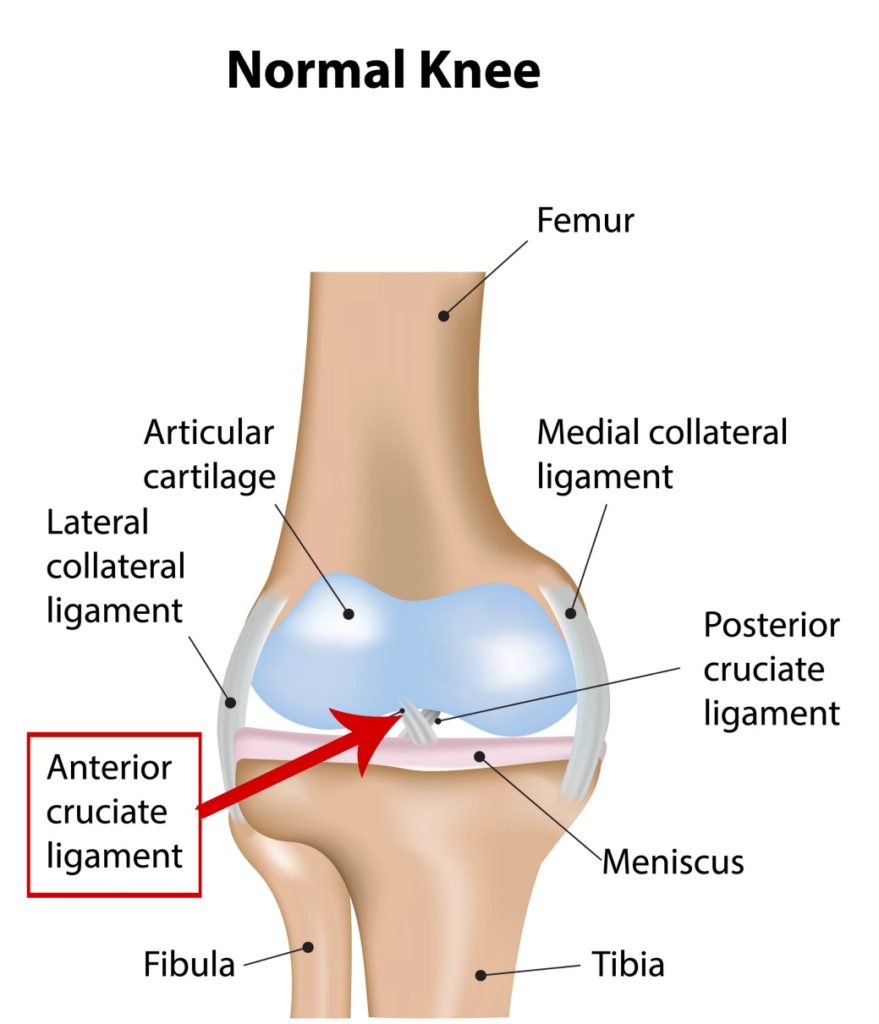Anterior cruciate ligament (ACL) tears are a common injury to the knee, especially among athletes. How can you tell if you have torn ACL or not? Today I wanted to share three easy tests we use as physical therapists to assess the integrity of your ligament and tell whether or not you may have a tear.

====================================
7 Days of awesome at-home workouts and delicious dinner recipes – delivered daily right to your inbox!
Sign up for our all-now “7-Day Home Workout and Recipe Plan” by clicking RIGHT HERE!
====================================
What are the ligaments of your knee?
 The four major ligaments that stabilize your knee joint are the anterior cruciate ligament (ACL), posterior cruciate ligament (PCL), medial collateral ligament (MCL) and lateral collateral ligament (LCL). These ligaments each serve to stabilize and support the knee in different directions.
The four major ligaments that stabilize your knee joint are the anterior cruciate ligament (ACL), posterior cruciate ligament (PCL), medial collateral ligament (MCL) and lateral collateral ligament (LCL). These ligaments each serve to stabilize and support the knee in different directions.
What is the ACL?
The anterior cruciate ligament (ACL) is one of four major ligaments that hold your knee together. The ACL attaches from the front of your tibia to the back of your femur and is key in providing stability to the knee. Specifically the ACL limits the motion of forward translation (forward “sliding”) of the tibia on the femur. It also serves to limit rotation of the tibia on the femur.
How do you injure your ACL?
Most injuries to the ACL are actually non-contact; no trauma from an outside force is involved. ACL injuries are typically sustained when your foot is planted and then you try to cut laterally or rotate. These motions apply maximum stress to the ACL and, with sufficiently high forces, can cause it to rupture. Another common cause is a blow/trauma to the outside of the knee when the foot is planted.
The most common injuries to the ACL I see in my physical therapy clinic come from soccer, football, and slips/falls.
What are the signs of an ACL injury?
The most common signs of an ACL injury are
- Hearing or feeling a “pop” in your knee

- Joint effusion (swelling in the knee)
- Bruising (depending on the severity of the rupture)
- Joint tenderness
- Instability (feeling like your knee could “give way” while standing, walking, going up/down stairs, etc).
How bad is my ACL injury?
Whenever healthcare professionals discuss ACL injuries, we talk about 3 different “degrees” of sprain.
- Grade One – the ligament has been stretched to capacity, but no significant structural damage has occurred to the ligament.
- Grade Two – a “partial tear” of the ACL. The ligament has been stretched beyond capacity and some micro-tearing has occurred. There may be some fraying to the outside structures of the ligament.
- Grade Three – a “complete rupture” of the ligament has occurred; AKA “torn ACL”. The ligament is no longer intact and requires surgical repair.
How can I check my ACL to see if it’s injured?
If you suspect you may have an ACL injury, you should go get it assessed by a medical professional (either a physical therapist or orthopedic doctor). These individuals are extensively trained in performing tests and measure to assess whether or not your ACL has been compromised.
There are three tests you can perform at home with the help of a friend or family member that will give you a better idea as to whether or not your ACL has been injured.
Push PLAY on the video below to see how each of these tests is performed…
1. History – one of the major predictors of ACL injury is the history of the injury. As mentioned previously, ACL injuries are typically accompanied by a “pop” that is either heard or felt, swelling, bruising, joint tenderness, and instability. These injuries are often traumatic in nature and happen suddenly as opposed to gradually over time.
2. How to perform Lachman’s Test
- Lay the subject on his/her back with his/her knee slightly bent (20 degrees).
- Stabilize the person’s femur with one hand and pull the tibia forward with the other.
- If the ACL is intact, you should feel a “catch” at the end limiting forward motion of the tibia on the femur.
3. How to perform an Anterior Drawer Test.
- Lay the subject on his/her back with his/her knee bent to 90 degrees.
- Sit lightly on the person’s foot and wrap your fingers around to the back of his/her knee.
- Pull the tibia forward towards you to assess how much motion there is.
- If the ACL is intact, there should be very little motion with a “firm” end feel.
- If there is an ACL injury, there might be excessive motion and an “empty” end feel (no catch limiting forwards translation.
If any of these tests are positive, chances are you’ve injured your ACL. The next step would be to go see a physical therapist or orthopedic doctor/surgeon to discuss your injury and your options. Please don’t hesitate in taking this important next step!
If you have any questions or comments about any of the information presented in this post please feel free to leave them in a comment to this post down below. I’ll get to them as soon as I can.
Looking for more great videos to help you feel better? Here are some great tips on how you can help some of the most-common ailments out there…
Be sure to follow Tone and Tighten on YouTube | Facebook | Instagram | Twitter | Pinterest
Make it happen,
Jared
Disclaimer: The information presented in this post is designed to be used for informational purposes only. The diagnoses and treatment plans are general and may or may not be the recommended interventions for your specific problem. If you are experiencing pain, you are encouraged to consult with a healthcare provider to determine the best treatment plan that will be in your best interest individual. Tone and Tighten claims exemption from accident, injury, or perpetuation of any injury incurred while performing these tests or any exercises found on this website. The user assumes all risk.
